Abstract
The diminished cardiac output response to exercise with advancing age may be attributable to intrinsic inability of the old ventricle to respond appropriately and/or to an additional loading imposed upon the ventricle by the aged vascular system. The steady (resistance) and pulsatile (characteristic impedance) load components together comprise the vascular load faced by the ejecting ventricle. To study the effect of exercise on both vascular components of load, the aortic input impedance was measured in chronically instrumented young and old beagle dogs during graded treadmill exercise before and after beta blockade. Ascending aortic flow was measured by a cuff electromagnetic flow probe, and pressure was measured by a high-fidelity semiconductor transducer. At low levels of exercise the old animals demonstrated a striking 20% increase in characteristic impedance and a 28% decrease in peripheral resistance with no increase in stroke volume. This vascular loading and limitation in stroke volume persisted across the higher exercise levels. In contrast, the young group demonstrated no increase in characteristic impedence, a progressive decrease in peripheral resistance, and a progressive increase in stroke volume across the same exercise levels. These age differences in vascular response and ventricular output were abolished by beta blockade. The groups did not demonstrate a difference in heart rate response, but the young had a greater increase in external left ventricular power than the old across exercise. These data demonstrated a profound difference in the response of young and old vasculature to exercise. At low and intermediate exercise levels the pulsatile vascular load appeared to be a major factor in the limitation of stroke volume in old dogs. At high levels of exercise, the limited exercise response in the old dog may be caused in part by a diminished inotropic responsiveness as well as by the vascular loading.
Full text
PDF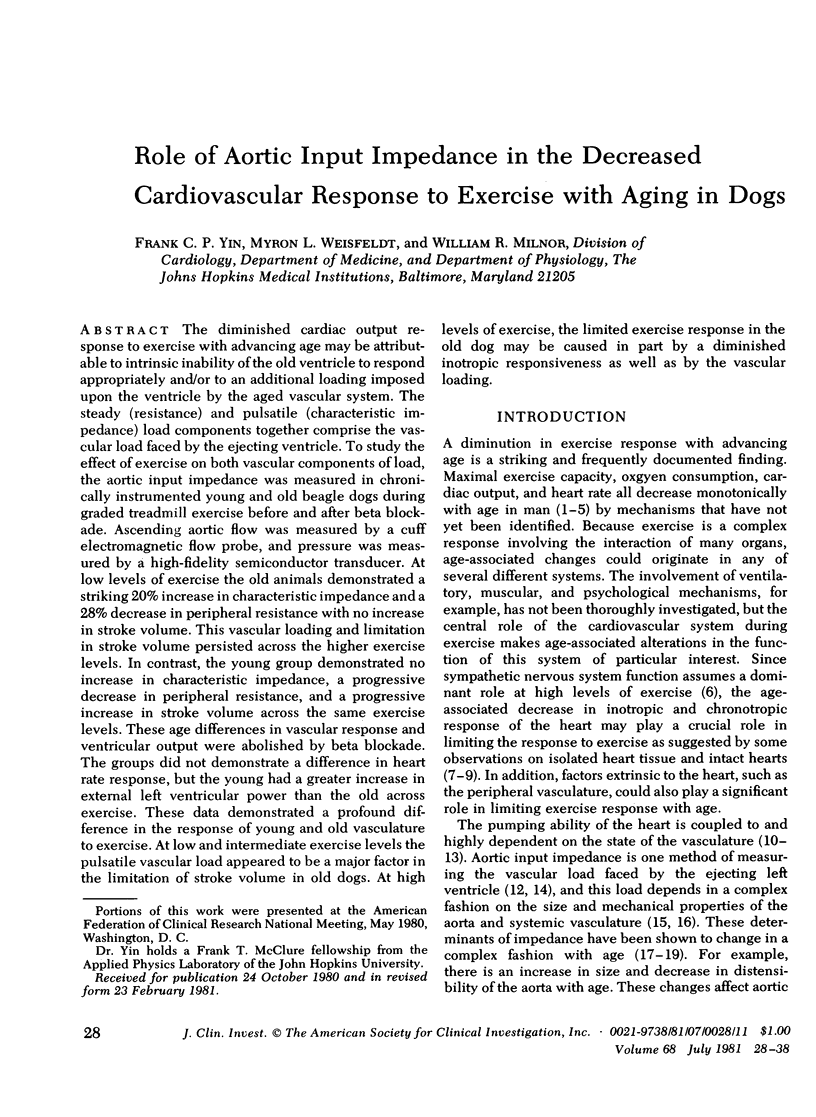
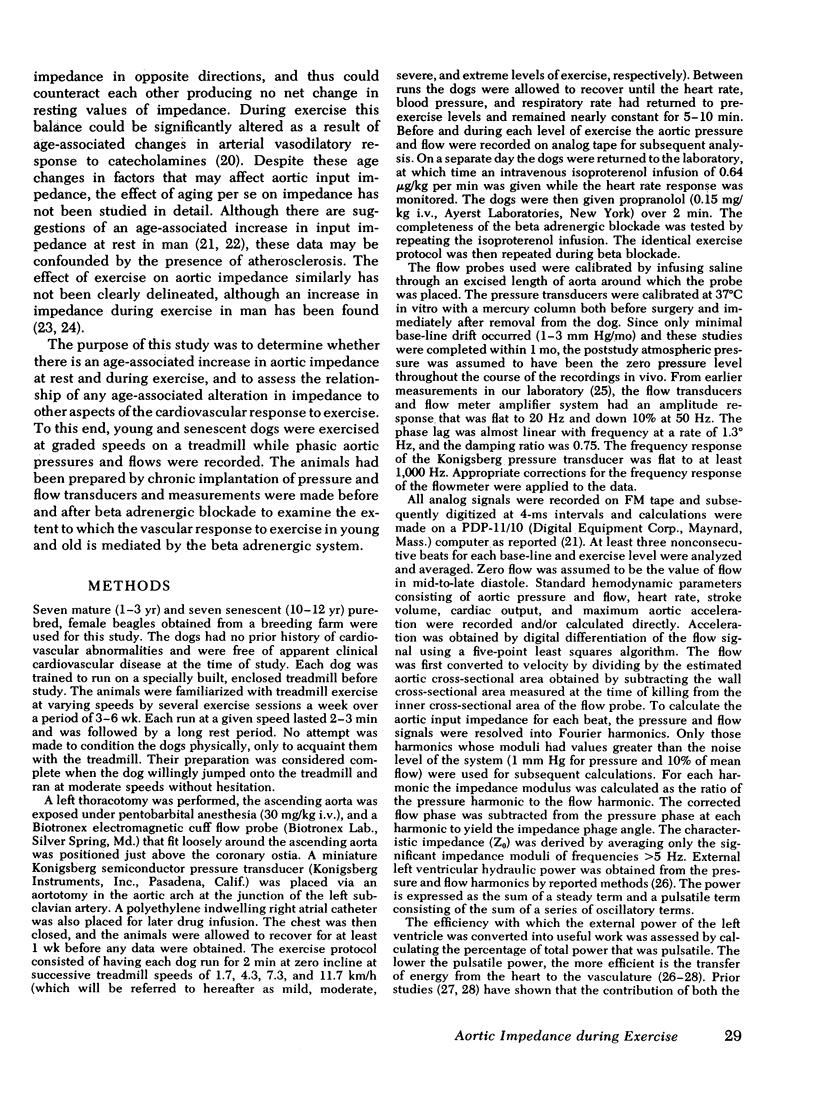
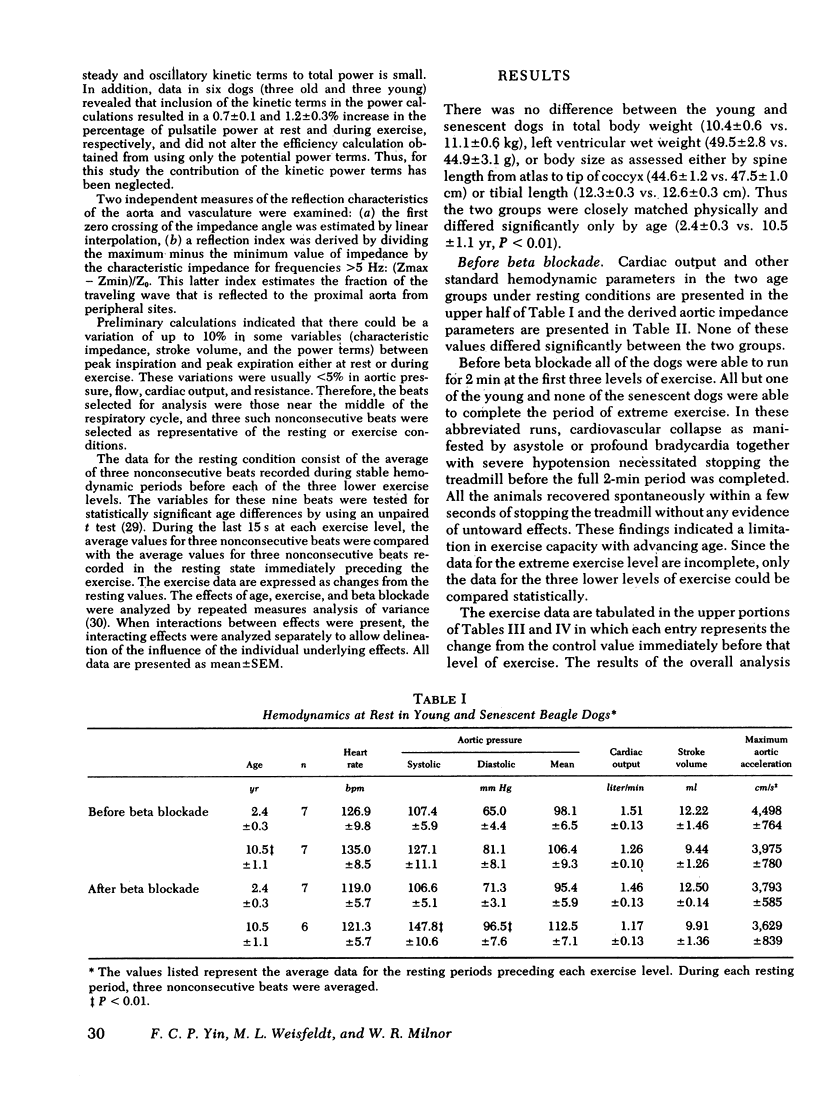
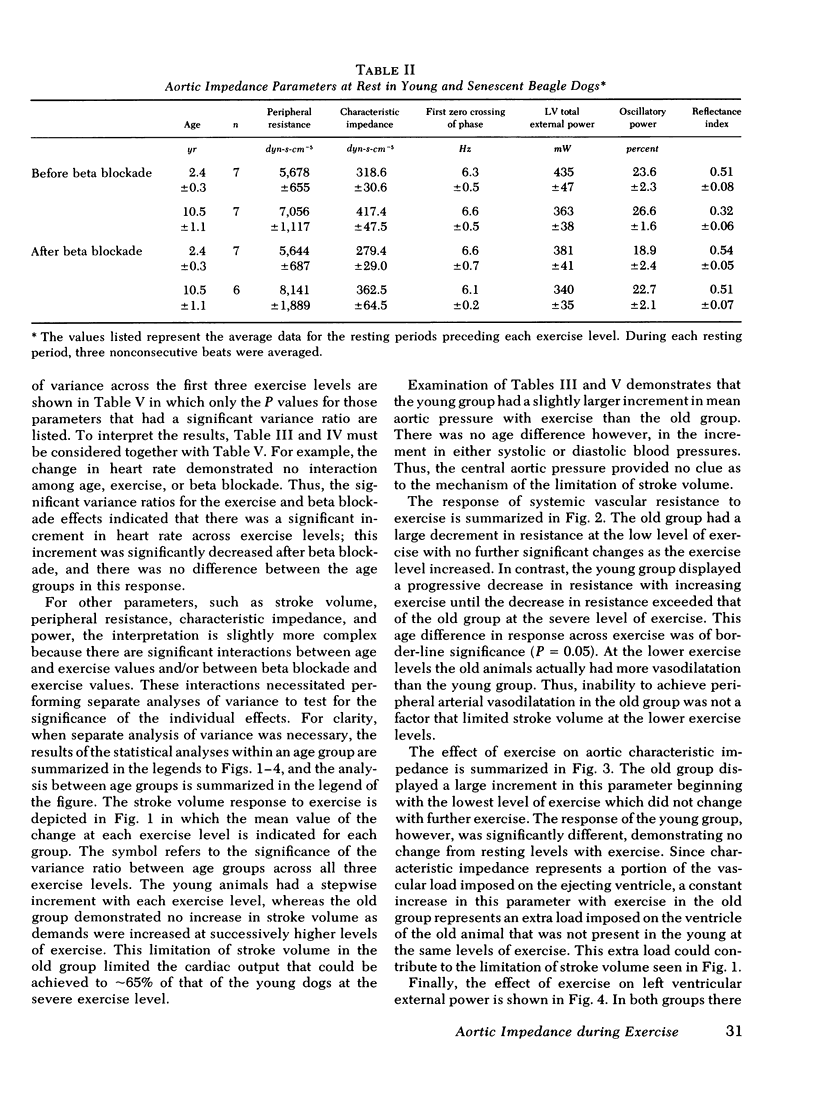
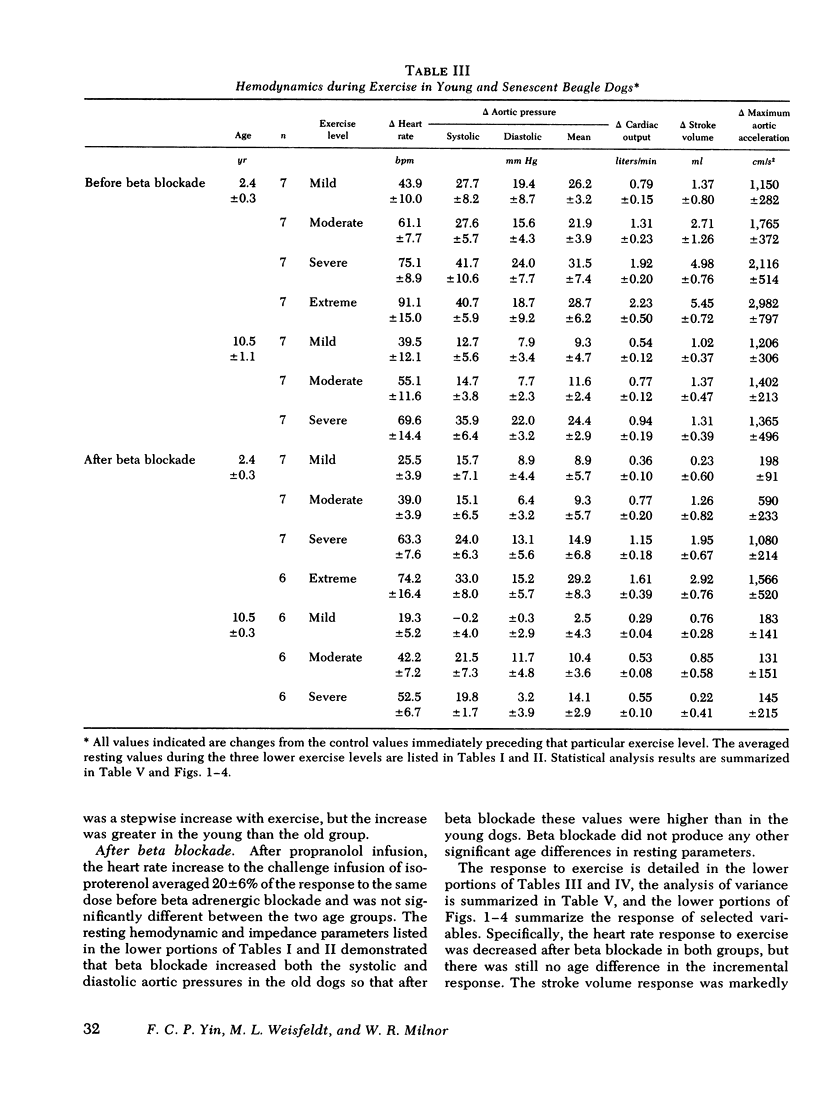
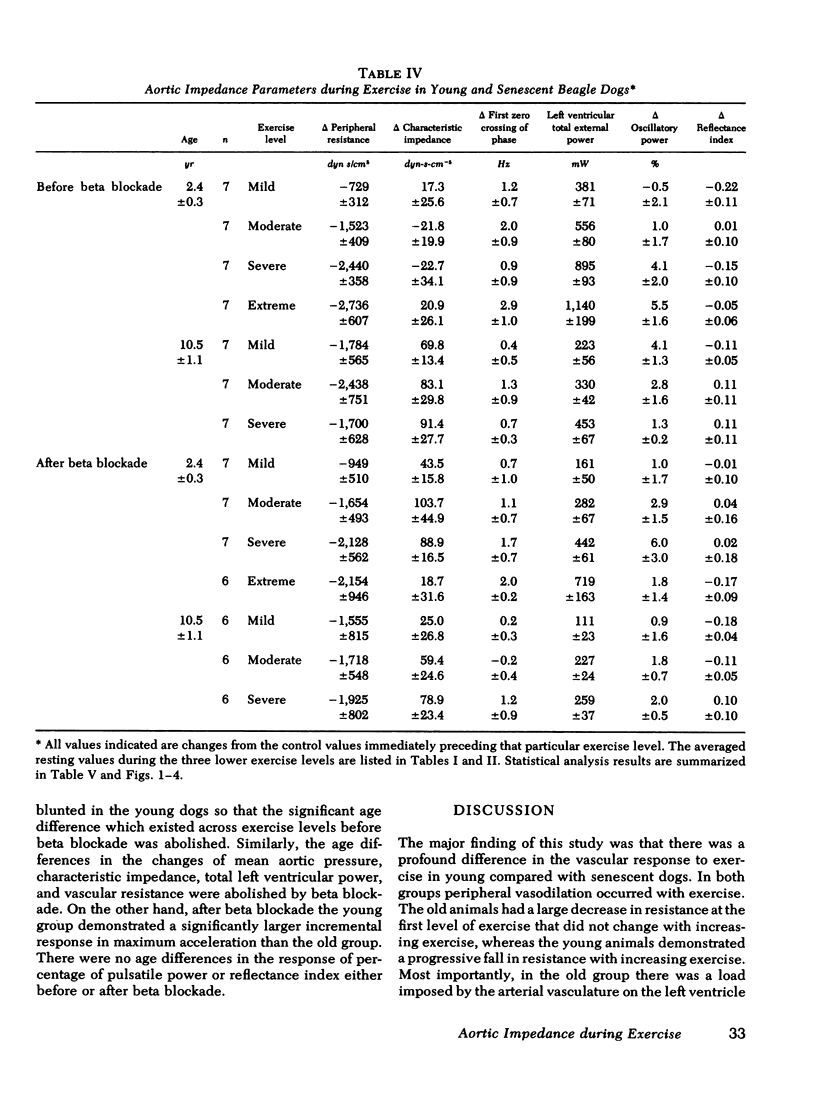
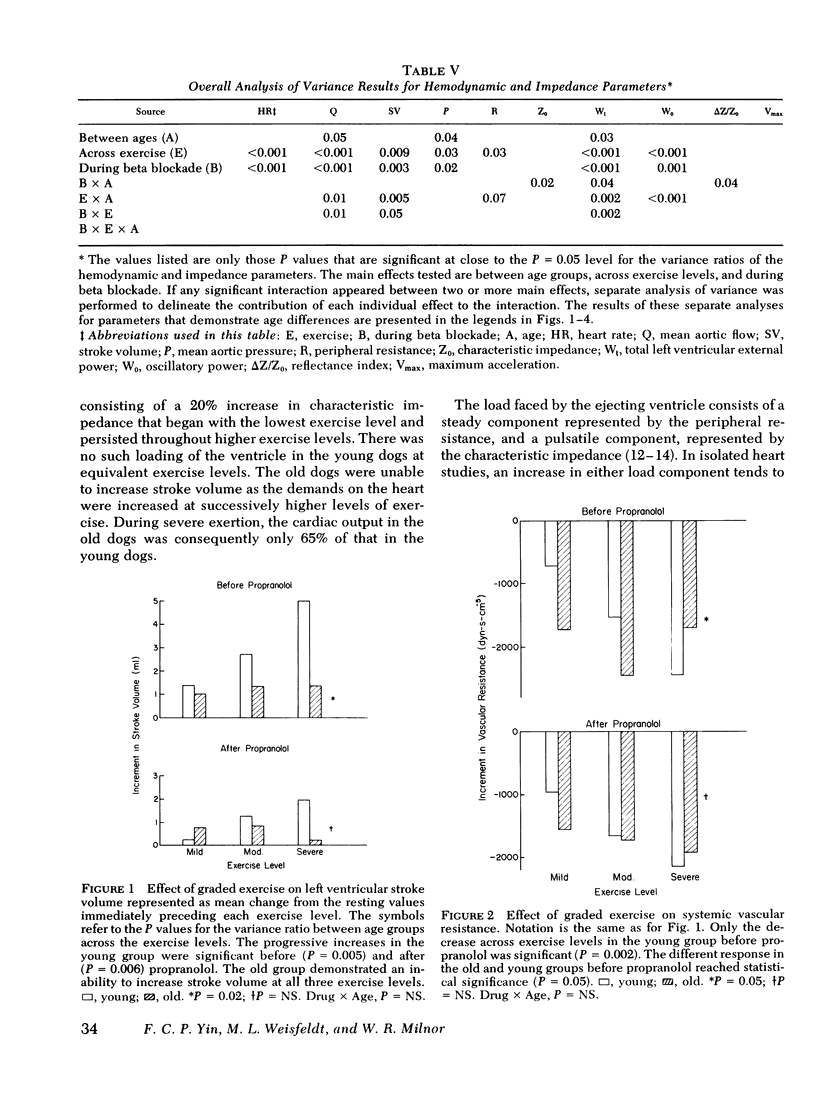
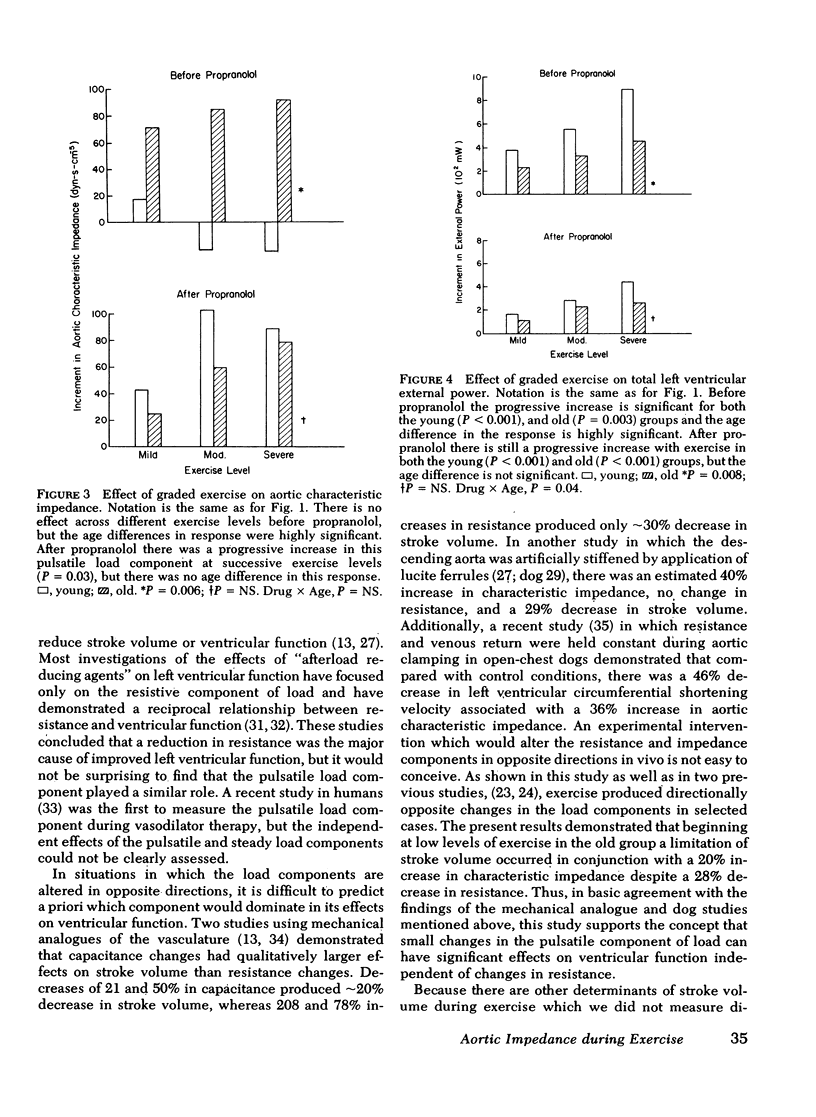
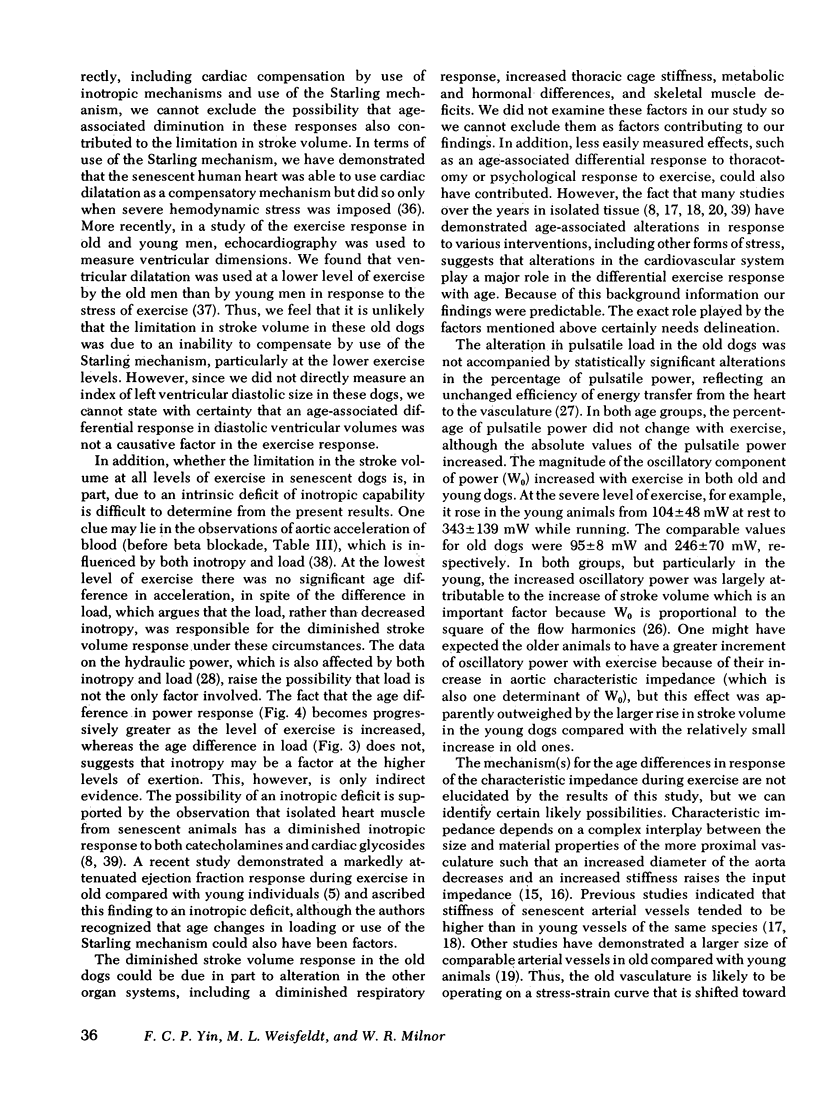
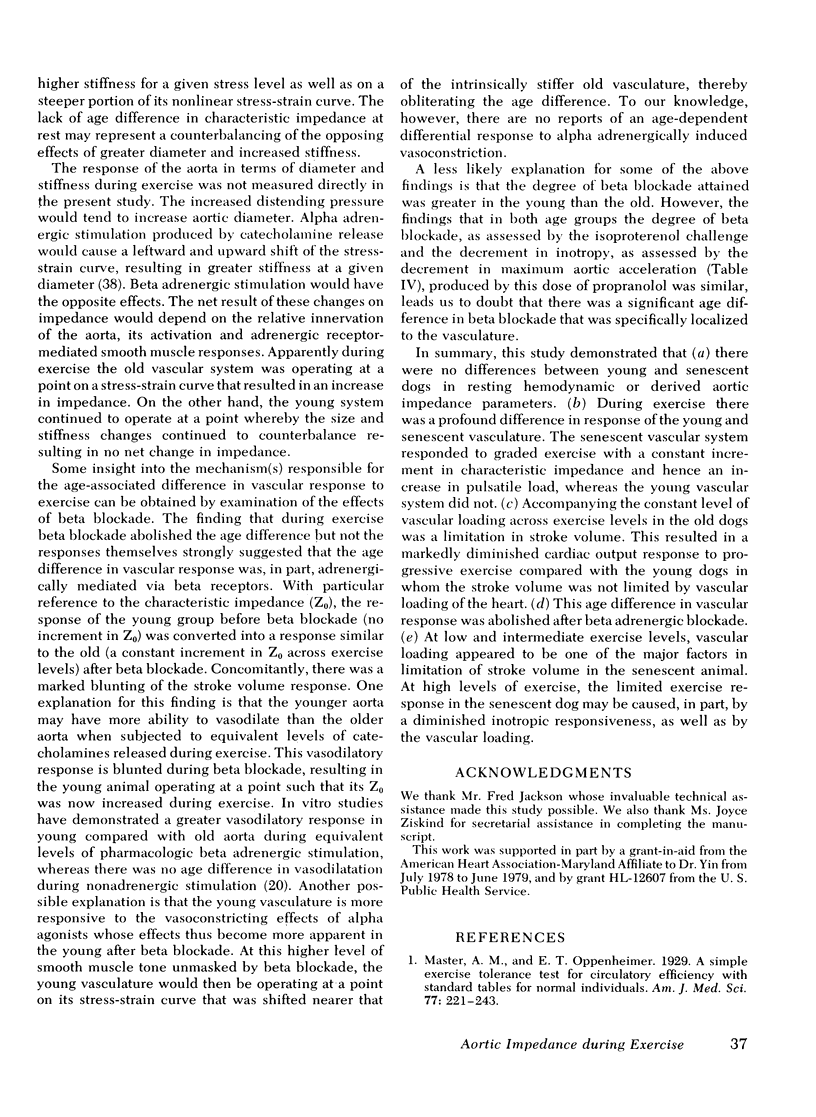
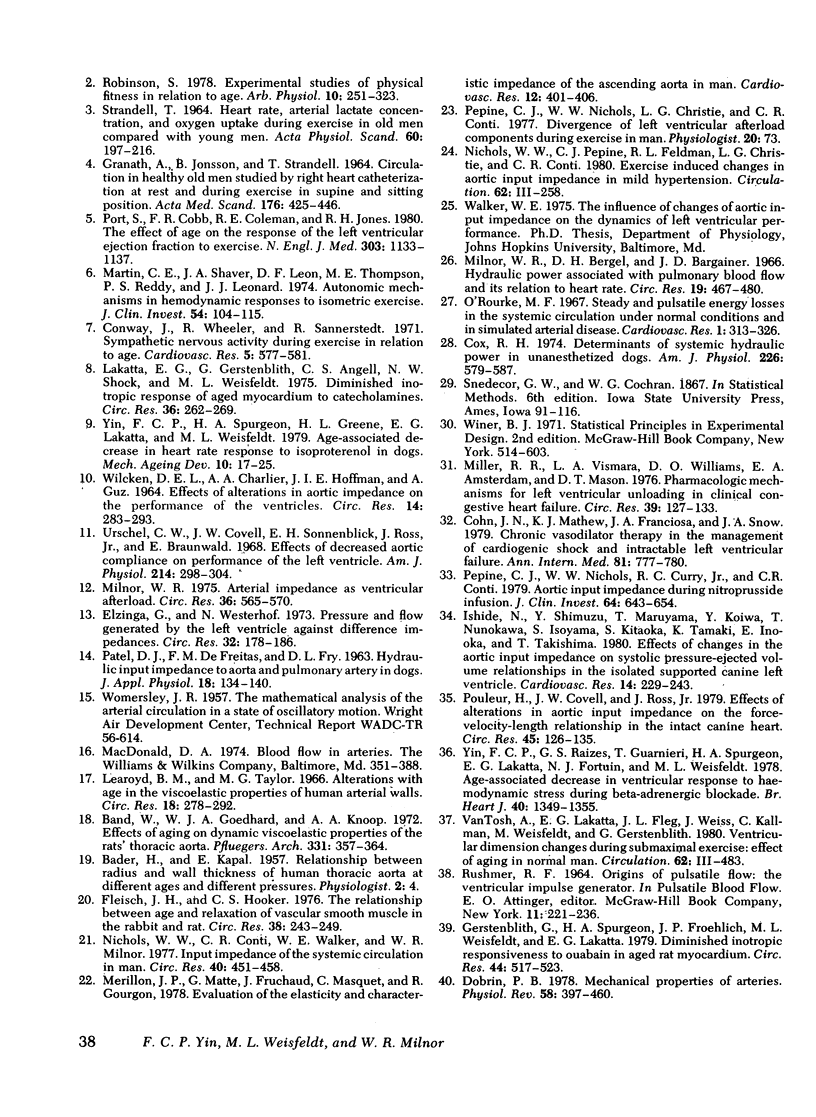
Selected References
These references are in PubMed. This may not be the complete list of references from this article.
- Band W., Goedhard W. J., Knoop A. A. Effects of aging on dynamic viscoelastic properties of the rat's thoracic aorta. Pflugers Arch. 1972;331(4):357–364. doi: 10.1007/BF00592696. [DOI] [PubMed] [Google Scholar]
- Cohn J. N., Mathew K. J., Franciosa J. A., Snow J. A. Chronic vasodilator therapy in the management of cardiogenic shock and intractable left ventricular failure. Ann Intern Med. 1974 Dec;81(6):777–780. doi: 10.7326/0003-4819-81-6-777. [DOI] [PubMed] [Google Scholar]
- Conway J., Wheeler R., Sannerstedt R. Sympathetic nervous activity during exercise in relation to age. Cardiovasc Res. 1971 Oct;5(4):577–581. doi: 10.1093/cvr/5.4.577. [DOI] [PubMed] [Google Scholar]
- Cox R. H. Determinants of systemic hydraulic power in unanesthetized dogs. Am J Physiol. 1974 Mar;226(3):579–587. doi: 10.1152/ajplegacy.1974.226.3.579. [DOI] [PubMed] [Google Scholar]
- Dobrin P. B. Mechanical properties of arterises. Physiol Rev. 1978 Apr;58(2):397–460. doi: 10.1152/physrev.1978.58.2.397. [DOI] [PubMed] [Google Scholar]
- Elzinga G., Westerhof N. Pressure and flow generated by the left ventricle against different impedances. Circ Res. 1973 Feb;32(2):178–186. doi: 10.1161/01.res.32.2.178. [DOI] [PubMed] [Google Scholar]
- Fleisch J. H., Hooker C. S. The relationship between age and relaxation of vascular smooth muscle in the rabbit and rat. Circ Res. 1976 Apr;38(4):243–249. doi: 10.1161/01.res.38.4.243. [DOI] [PubMed] [Google Scholar]
- GRANATH A., JONSSON B., STRANDELL T. CIRCULATION IN HEALTHY OLD MEN, STUDIED BY RIGHT HEART CATHETERIZATION AT REST AND DURING EXERCISE IN SUPINE AND SITTING POSITION. Acta Med Scand. 1964 Oct;176:425–446. doi: 10.1111/j.0954-6820.1964.tb00949.x. [DOI] [PubMed] [Google Scholar]
- Gerstenblith G., Spurgeon H. A., Froehlich J. P., Weisfeldt M. L., Lakatta E. G. Diminished inotropic responsiveness to ouabain in aged rat myocardium. Circ Res. 1979 Apr;44(4):517–523. doi: 10.1161/01.res.44.4.517. [DOI] [PubMed] [Google Scholar]
- Ishide N., Shimizu Y., Maruyama Y., Koiwa Y., Nunokawa T., Isoyama S., Kitaoka S., Tamaki K., Ino-Oka E., Takishima T. Effects of changes in the aortic input impedance on systolic pressure-ejected volume relationships in the isolated supported canine left ventricle. Cardiovasc Res. 1980 Apr;14(4):229–243. doi: 10.1093/cvr/14.4.229. [DOI] [PubMed] [Google Scholar]
- Lakatta E. G., Gerstenblith G., Angell C. S., Shock N. W., Weisfeldt M. L. Diminished inotropic response of aged myocardium to catecholamines. Circ Res. 1975 Feb;36(2):262–269. doi: 10.1161/01.res.36.2.262. [DOI] [PubMed] [Google Scholar]
- Learoyd B. M., Taylor M. G. Alterations with age in the viscoelastic properties of human arterial walls. Circ Res. 1966 Mar;18(3):278–292. doi: 10.1161/01.res.18.3.278. [DOI] [PubMed] [Google Scholar]
- Martin C. E., Shaver J. A., Leon D. F., Thompson M. E., Reddy P. S., Leonard J. J. Autonomic mechanisms in hemodynamic responses to isometric exercise. J Clin Invest. 1974 Jul;54(1):104–115. doi: 10.1172/JCI107731. [DOI] [PMC free article] [PubMed] [Google Scholar]
- Merillon J. P., Motte G., Fruchaud J., Masquet C., Gourgon R. Evaluation of the elasticity and characteristic impedance of the ascending aorta in man. Cardiovasc Res. 1978 Jul;12(7):401–406. doi: 10.1093/cvr/12.7.401. [DOI] [PubMed] [Google Scholar]
- Miller R. R., Vismara L. A., Williams D. O., Amsterdam E. A., Mason D. T. Pharmacological mechanisms for left ventricular unloading in clinical congestive heart failure. Differential effects of nitroprusside, phentolamine, and nitroglycerin on cardiac function and peripheral circulation. Circ Res. 1976 Jul;39(1):127–133. doi: 10.1161/01.res.39.1.127. [DOI] [PubMed] [Google Scholar]
- Milnor W. R. Arterial impedance as ventricular afterload. Circ Res. 1975 May;36(5):565–570. doi: 10.1161/01.res.36.5.565. [DOI] [PubMed] [Google Scholar]
- Milnor W. R., Bergel D. H., Bargainer J. D. Hydraulic power associated with pulmonary blood flow and its relation to heart rate. Circ Res. 1966 Sep;19(3):467–480. doi: 10.1161/01.res.19.3.467. [DOI] [PubMed] [Google Scholar]
- Nichols W. W., Conti C. R., Walker W. E., Milnor W. R. Input impedance of the systemic circulation in man. Circ Res. 1977 May;40(5):451–458. doi: 10.1161/01.res.40.5.451. [DOI] [PubMed] [Google Scholar]
- O'Rourke M. F. Steady and pulsatile energy losses in the systemic circulation under normal conditions and in simulated arterial disease. Cardiovasc Res. 1967 Oct;1(4):313–326. doi: 10.1093/cvr/1.4.313. [DOI] [PubMed] [Google Scholar]
- PATEL D. J., DEFREITAS F. M., FRY D. L. Hydraulic input impedance to aorta and pulmonary artery in dogs. J Appl Physiol. 1963 Jan;18:134–140. doi: 10.1152/jappl.1963.18.1.134. [DOI] [PubMed] [Google Scholar]
- Pepine C. J., Nichols W. W., Curry R. C., Jr, Conti C. R. Aortic input impedance during nitroprusside infusion. A reconsideration of afterload reduction and beneficial action. J Clin Invest. 1979 Aug;64(2):643–654. doi: 10.1172/JCI109505. [DOI] [PMC free article] [PubMed] [Google Scholar]
- Port S., Cobb F. R., Coleman R. E., Jones R. H. Effect of age on the response of the left ventricular ejection fraction to exercise. N Engl J Med. 1980 Nov 13;303(20):1133–1137. doi: 10.1056/NEJM198011133032001. [DOI] [PubMed] [Google Scholar]
- Pouleur H., Covell J. W., Ross J., Jr Effects of alterations in aortic input impedance on the force-velocity-length relationship in the intact canine heart. Circ Res. 1979 Jul;45(1):126–136. doi: 10.1161/01.res.45.1.126. [DOI] [PubMed] [Google Scholar]
- STRANDELL T. HEART RATE, ARTERIAL LACTATE CONCENTRATION AND OXYGEN UPTAKE DURING EXERCISE IN OLD MEN COMPARED WITH YOUNG MEN. Acta Physiol Scand. 1964 Mar;60:197–216. doi: 10.1111/j.1748-1716.1964.tb02883.x. [DOI] [PubMed] [Google Scholar]
- Urschel C. W., Covell J. W., Sonnenblick E. H., Ross J., Jr, Braunwald E. Effects of decreased aortic compliance on performance of the left ventricle. Am J Physiol. 1968 Feb;214(2):298–304. doi: 10.1152/ajplegacy.1968.214.2.298. [DOI] [PubMed] [Google Scholar]
- WILCKEN D. E., CHARLIER A. A., HOFFMAN J. I., GUZ A. EFFECTS OF ALTERATIONS IN AORTIC IMPEDANCE ON THE PERFORMANCE OF THE VENTRICLES. Circ Res. 1964 Apr;14:283–293. doi: 10.1161/01.res.14.4.283. [DOI] [PubMed] [Google Scholar]
- Yin F. C., Raizes G. S., Guarnieri T., Spurgeon H. A., Lakatta E. G., Fortuin N. J., Weisfeldt M. L. Age-associated decrease in ventricular response to haemodynamic stress during beta-adrenergic blockade. Br Heart J. 1978 Dec;40(12):1349–1355. doi: 10.1136/hrt.40.12.1349. [DOI] [PMC free article] [PubMed] [Google Scholar]
- Yin F. C., Spurgeon H. A., Greene H. L., Lakatta E. G., Weisfeldt M. L. Age-associated decrease in heart rate response to isoproterenol in dogs. Mech Ageing Dev. 1979 Apr;10(1-2):17–25. doi: 10.1016/0047-6374(79)90067-8. [DOI] [PubMed] [Google Scholar]


